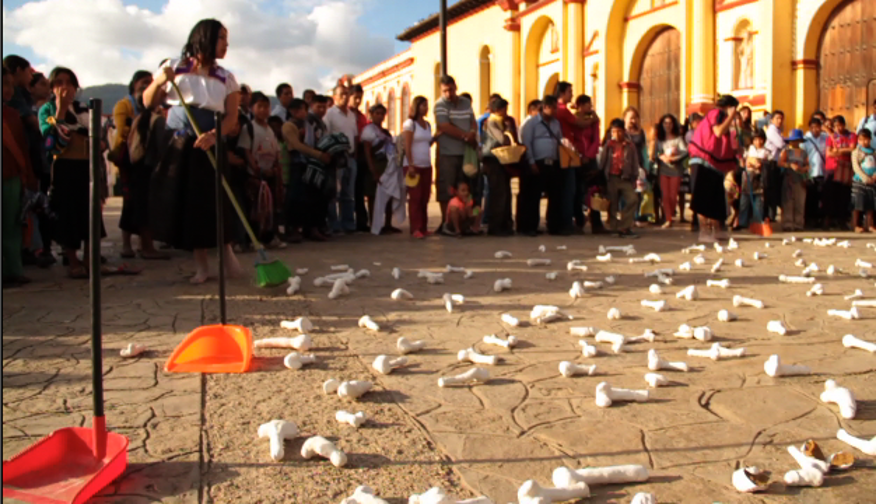Body, Land, Dream: The Contested Sites
The Sailing Stones Act, installation view, Kaplan Gallery, VisArts
MIA EVE ROLLOW
The Sailing Stones Act
July 7, 2020 – January 3, 2021
Kaplan Gallery, VisArts
"
Many words are walked in the world. Many worlds are made. Many worlds make us. There are words and worlds that are lies and injustices. There are words and worlds that are truthful and true. In the world of the powerful there is room only for the big and their helpers. In the world we want, everybody fits. The world we want is a world in which many worlds fit.
— Ejército Zapatista de Liberación Nacional,
The Fourth Declaration of the Lacandón Jungle
Sailing stone at Racetrack Playa in Death Valley National Park. (Image: ©Anatoliy Lukich | Shutterstock.com)
Through a seemingly magical phenomenon, sailing stones transcend their weight and slide across smooth expanses of dirt, inscribing paths over time. A stone moves only when the conditions and qualities of wind, water, ice, dirt, mineral, and site combine in a specific way. Movement depends on a collaboration of forces. Under the right circumstances, bodies of rock, from a few ounces to hundreds of pounds, defy their parameters as fixed and immutable and resonate with the power of change.
In Mia Eve Rollow’s exhibition, The Sailing Stones Act, individual and community bodies move across physical, psychic, political, and social terrain powered by poetic acts of resistance and transformation. Featuring selections from a body of work produced by Mia through EDELO Migrante, a nomadic, globally engaged collective of artistic practice, the exhibition is the first major solo of this under-recognized artist whose creative work has been centered outside of a gallery construct and within the communities where she lives and works. Arranged as a multi-media installation, the exhibition includes large scale projected videos of collaborative performances from over a decade of the artist’s community-based, site specific work in Mexico, India, and Palestine.
Women inch along ridges of bare ground on their backs, their feet tied at the ankles. Released from one another, they slide down hills of dirt to stillness, their bodies in constant contact with the land. Villagers emerge from the fog. A small breeze rattles dried corn plants. The sound of a shovel breaking hard ground. A man cartwheels across a grassy pasture. The tinkling of bells, a rooster crowing, quiet voices, and soft laughter. Children navigate village paths working together to keep a swath of cloth afloat above their heads to catch rain. A limbless man becomes a Mayan god holding the center of a transforming symbol shaped from cast legs and arms. The artist drags herself across the sand and disappears with others into a hole in the sand.
Sound and images combine in a surreal, synchronic dream from multi-channel video projections. A single large-scale drawing shimmers in the reflected projection light. Meant to be explored with a personal handheld light, it reveals an iconography derived from dreams, plant medicine ceremonies, and meditations that served as source material for some of the performances. Stories, processions, and protest from places thousands of miles apart come together in an irrepressible spirit of autonomy and visibility. Walking through the gallery, viewers encounter seventeen stories, co-authored by artists and non-artists with Mia, of collective actions across time and space that address mobility, land rights, displacement, trauma, child labor, femicide, and self-determination. Body, land, and dream are inextricably entwined. The ephemeral magic of the original ceremonial performances is re-embodied in the video documents and gathering of works in the exhibition.
Padre No Me Pegues/ Father Don’t Hit Me, installation view, Kaplan Gallery, VisArts
In 2009 Mia Eve Rollow and Caleb Duarte founded EDELO (En Donde Era La ONU/Where the United Nations Used to Be) a social practice project, intercultural artist residency, experimental art laboratory, and safe house in Chiapas, Mexico. “The work at its core,” states Mia, “focused on the lessons and use of art by the EZLN, the Zapatista autonomous indigenous movement in Chiapas, Mexico as a main tool to demand immediate and drastic social and economic change as a response to 500 years of invisibility, oppression, and neglect.” What sprouted from EDELO were community events, performances, and workshops that drew on social practice, relational aesthetics, and social sculpture– an aesthetics of urgency and social dynamics. Key to understanding EDELO is the fact that it was founded in the same building where the United Nations finally relinquished their offices after sustained occupation by displaced indigenous community members who hoped to gain international attention from humanitarian organizations. That urgency combined with sustained, experimental community action was fundamental to the ethos of EDELO.
Many Worlds, still from video featuring Bartolo Martinez
"
A death experience from which one part of me returned and the rest remained in a mysterious infinite space,
is how Mia describes a traumatic accident that left her paralyzed from the waist down and with intractable pain. It precipitated her search for psychic and physical healing leading to learning from the art of the Zapatistas and becoming familiar with Mayan shamanism and cosmology. In Mexico, she began to create experimental and surreal artworks along with individuals and communities incorporating psychomagic acts and art as tools for healing and transformation. The work relied on transdisciplinary forms including sculpture, theater, and performance, workshops, conversations, and interviews. Movement emerged as a node of inquiry, bringing into focus physical, mental, spiritual, cultural, and social challenges of mobility. The movement from one state to another or from one place to another requires resilience and resourcefulness. The aesthetic and process of the work, from preparation through enactment to reflection, aligns with lessons from Zapatismo and ritual practice. Rituals and ceremonies are intentional journeys to gather wisdom and tools for survival. According to Mia, “Dignity rests at the heart of each action. Limits are met with creativity and imagination. The dream for an inclusive, humane, and wise society lights every step.” 2
Mia never backs away from a view that life and death, inner and outer states of being, are a commingling of raw viscerality and tenderness. Bodies move across the land and disappear into the land. Construction and deconstruction, visibility and invisibility, movement and stillness repeat in her work. The liminal threshold is crossed with the help of many, but it is often rigorous work requiring time and trust. Bartolo Martinez carves his legs and then after a brief moment of sitting upon them, breaks them up as he tells his mystical story of his encounter with god. Santos Hernandez gestures and screams in anger, pain or with warrior determination, before transforming into a Mayan god and placed at the center of an ancient symbol of abundance, the same symbol used by the Nazis who killed most of Mia’s ancestors. Entierro/Burial, a two channel video, begins with a procession of villagers to a site where they break the hard land to perform a ritual burial. Indigenous Mayan children struggle to carry the bodies of Caleb Duarte and Mia into a grave. They tenderly cover them with dirt. The performance occurs over a long span of time. Digging the grave is hard work shared by many. At the end of the video, the children follow artist Emory Douglas in a tight joyful procession that ends with clapping and laughing. Mia’s description relates the friction of differing cultural orientations toward death and the possible movement toward healing the deep wounds of colonization, race, and discrimination. Caleb, Emory, and Mia serve as representatives of disenfranchised communities (Latino, Black, disabled) within the privileged United States.
Padre No Me Pegues/ Father Don’t Hit Me, still from video
In a public performance with actresses Dalia Perez and Adriana Tomy Santiz from the Mayan Chamula community in Chiapas, Padre No Me Pegues/ Father Don’t Hit Me, two women sweep gesso penis sculptures from the street and throw them in the trash in a demonstration addressing gender violence and femicide. The back story reveals the public eager to take a penis sculpture home, a policewoman who overlooks the need for a permit for the performance, and the participants overcoming their shyness through the co-creation and performance of this action in the central plaza.
Somewhere in Palestine, installation view, Kaplan Gallery, VisArts
Somewhere in Palestine symbolically revisits the experiences of men who have endured severe disabilities due to the violence from the occupation of their land. The exact location and names of the collaborators remain anonymous due to the risk of Israeli police action. The video ends with Palestinian refugees lifting and carrying heavy stones that transform and light the streets of the camp. The collaboration brought Mia to a self-directed two-month residency where she lived with a family in a Palestinian refugee camp. She had to make the decision of what to wear to bed at night in case she had to flee immediately in her wheelchair- the smell of gasoline and the sound of explosions going off outside her door.
"
To see this, to live this, if that doesn’t
mark you for the rest of your life,
said the author José Saramago in recollection of his father, who in old age and sickness, embraced his fig and olive trees and cried as he said goodbye to them knowing that he would not return.3 The stories and actions presented by Mia and EDELO Migrante in The Sailing Stones Act, bear similar wrenching connections to land and fulfillment, leaving marks of change upon participants and witnesses alike.
In a time of great political and social fracture across the globe, the conversations and decisions raised by the work of Mia and EDELO Migrante remain urgent. These urgent conversations can be difficult and uncomfortable, but the outcome may offer movement to a place of healing and the co-creation of a world of dignity, respect, and representation. Mia believes that art is a radical form of communication and a magical form of knowledge. It does not exist only within the parameters of an art world of commerce, but in an inclusive world and its contexts. It is a miracle when all the molecules line up and something happens. Art offers an opening for healing and transformation. To move a heavy stone requires a gathering of forces.
Susan Main
Curator
Alejandro Jodorowsky, Psychomagic: The Transformative Power of Shamanic Psychotherapy, (New York: Simon and Schuster, 2010), prologue. Alexander Jodorowsky coined the term psychomagic to describe a healing therapy that could use the powers of dreams, art, and theater to empower individuals to heal wounds that in some cases had traveled through generations. The roots of this therapy are found in the practices of indigenous healers. “Having lived many years in Mexico, I had the opportunity to study the methods of those called “witches” or “folk healers.”
John Holloway, “Dignity’s Revolt,” http://cril.mitotedigital.org/sites/default/files/content/zap-dignitys_revolt-holloway.pdf “Dignity, the refusal to accept humiliation and dehumanisation, the refusal to conform: dignity is the core of the Zapatistas' revolution of revolution. When the Zapatistas rose, they planted the flag of dignity not just in the centre of the uprising in Chiapas, but in the centre of oppositional thought. Dignity is not peculiar to the indigenous peoples of the southeast of Mexico: the struggle to convert 'dignity and rebellion into freedom and dignity' (an odd but important formulation) is the struggle of (and for) human existence in an oppressive society as relevant to life in Edinburgh, Athens, Tokyo, Los Angeles or Johannesburg as it is to the struggles of the peoples of the Lacandon Jungle.” p. 1.
Alan Riding, “A Writer With an Ear for the Melody of Peasant Speech; The New Nobel Prize Winner Jose Saramago Trains an Outsider's Irony on Time, Faith and History,” The New York Times, December 3, 1998, Section E, p. 1.






